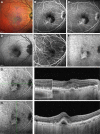Spotlight on reticular pseudodrusen
- PMID: 29033536
- PMCID: PMC5614782
- DOI: 10.2147/OPTH.S130165
Spotlight on reticular pseudodrusen
Abstract
Age-related macular degeneration (AMD) is a leading cause of vision loss in patients >50 years old. The hallmark of the disease is represented by the accumulation of extracellular material between retinal pigment epithelium and the inner collagenous layer of Bruch's membrane, called drusen. Although identified almost 30 years ago, reticular pseudodrusen (RPD) have been recently recognized as a distinctive phenotype. Unlike drusen, they are located in the subretinal space. RPD are strongly associated with late AMD, especially geographic atrophy, type 2 and 3 choroidal neovascularization, which, in turn, are less common in typical AMD. RPD identification is not straightforward at fundus examination, and their identification should employ at least 2 different imaging modalities. In this narrative review, we embrace all aspects of RPD, including history, epidemiology, histology, imaging, functional test, natural history and therapy.
Keywords: age-related macular degeneration; choroidal neovascularization; geographic atrophy; reticular drusen; reticular macular degeneration; reticular macular disease; reticular pseudodrusen; subretinal drusenoid deposit.
Conflict of interest statement
Disclosure GQ is a consultant for Alimera Sciences (Alpharetta, Georgia, USA), Allergan Inc. (Irvine, California, USA), Bayer Schering-Pharma (Berlin, Germany), Heidelberg (Germany), Novartis (Basel, Switzerland), Sandoz (Berlin, Germany), Zeiss (Dublin, OH, USA). FB has the following disclosures: Allergan (s), Alimera (s), Bayer (s), Farmila-Thea (s), Schering Pharma (s), Sanofi-Aventis (s), Novagali (s), Pharma (s), Hoffmann-La Roche (s), Genentech (s) and Novartis (s). The other authors report no conflicts of interest in this work.
Figures



References
-
- Lim LS, Mitchell P, Seddon JM, Holz FG, Wong TY. Age-related macular degeneration. Lancet. 2012;379(9827):1728–1738. - PubMed
-
- Mimoun G, Soubrane G, Coscas G. Les drusen maculaires. [Macular drusen] J Fr Ophtalmol. 1990;13(10):511–530. French. - PubMed
-
- Klein R, Davis MD, Magli YL, Segal P, Klein BE, Hubbard L. The Wisconsin age-related maculopathy grading system. Ophthalmology. 1991;98(7):1128–1134. - PubMed
-
- Arnold JJ, Sarks SH, Killingsworth MC, Sarks JP. Reticular pseudodrusen. A risk factor in age-related maculopathy. Retina. 1995;15(3):183–191. - PubMed
-
- Finger RP, Chong E, McGuinness MB, et al. Reticular Pseudodrusen and Their Association with Age-Related Macular Degeneration: The Melbourne Collaborative Cohort Study. Ophthalmology. 2016;123(3):599–608. - PubMed
Publication types
LinkOut - more resources
Full Text Sources
Other Literature Sources

